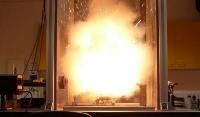New way of detecting concealed radioactive material
University of Maryland researchers propose method to sniff out dirty bombs via the electromagnetic breakdown of air
Researchers at the University of Maryland have proposed a scheme for detecting a concealed source of radioactive material without searching containers one by one. Detection of radioactive material concealed in shipping containers is important in the early prevention of "dirty" bomb construction. The concept, described in the Journal of Applied Physics, is based on the gamma-ray emission from the radioactive material that would pass through the shipping container walls and ionize the surrounding air.
The facilitated breakdown of the air in a focused beam of high-power, coherent, terahertz or infrared radiation would then be an indicator of the presence of the radioactive material. The gamma rays coming through the container walls could be detected by a pulsed electromagnetic source of duration between 10 ns to microseconds.
The team evaluated several candidate sources for this detection, including a 670-GHz gyrotron oscillator with 200-kW, 10-µs output pulses and a TEA CO2 laser with 30-MW, 100-ns output pulses. A system based on the 670-GHz gyrotron would have enhanced sensitivity and a range exceeding 10 m.
"It is not yet clear whether this approach to detection of nuclear material is practical," says first author professor Victor Granatstein, "but it is worth pursuing since it might impact an important need related to National Security."
Most read news
Organizations
Other news from the department science

Get the analytics and lab tech industry in your inbox
By submitting this form you agree that LUMITOS AG will send you the newsletter(s) selected above by email. Your data will not be passed on to third parties. Your data will be stored and processed in accordance with our data protection regulations. LUMITOS may contact you by email for the purpose of advertising or market and opinion surveys. You can revoke your consent at any time without giving reasons to LUMITOS AG, Ernst-Augustin-Str. 2, 12489 Berlin, Germany or by e-mail at revoke@lumitos.com with effect for the future. In addition, each email contains a link to unsubscribe from the corresponding newsletter.


























































